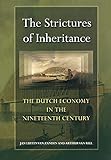The Strictures of Inheritance : The Dutch Economy in the Nineteenth Century / Jan Luiten van Zanden, Arthur van Riel.
Material type: TextSeries: The Princeton Economic History of the Western World ; 107Publisher: Princeton, NJ : Princeton University Press, [2022]Copyright date: ©2004Description: 1 online resource (416 p.) : 32 line illus. 54 tablesContent type:
TextSeries: The Princeton Economic History of the Western World ; 107Publisher: Princeton, NJ : Princeton University Press, [2022]Copyright date: ©2004Description: 1 online resource (416 p.) : 32 line illus. 54 tablesContent type: - 9780691229300
- BUSINESS & ECONOMICS / Economic History
- Agriculture (Chinese mythology)
- Agriculture
- Balance of trade
- Bank
- Bankruptcy
- Budget
- Capital market
- Case study
- Cashier
- Colonial surplus
- Commodity
- Comparative advantage
- Competition
- Corporatism
- Credit risk
- Cultivation System
- Currency
- Customer
- Demand For Labor
- Democratization
- Dividend
- Economic Life
- Economic development
- Economic growth
- Economic policy
- Economics
- Economist
- Economy of the Netherlands
- Economy
- Employment
- Entrepreneurship
- Expenditure
- Expense
- Financial crisis
- Financial services
- Fiscal policy
- Fourth Anglo-Dutch War
- Free trade
- Government Paper
- Government bond
- Government debt
- Haarlem
- Income
- Industrial production
- Industrialisation
- Industry
- Infrastructure
- Institution
- Insurance
- Interest rate
- International trade
- Investment
- Investor
- Laborer
- Legislation
- Liberalization
- Manufacturing
- Manure
- Market price
- Measures of national income and output
- Middle class
- National accounts
- Patriot movement
- Payment
- Political entrepreneur
- Politician
- Politics
- Poor relief
- Poverty
- Primary sector of the economy
- Productivity
- Protectionism
- Public finance
- Real wages
- Recession
- Relative price
- Retail
- Rye bread
- Saving
- Scarcity
- Secondary sector of the economy
- Service Sector
- Shipbuilding
- Shortage
- Stadtholder
- State formation
- Subsidy
- Supply (economics)
- Tariff
- Tax
- Textile industry
- Trade union
- Transaction cost
- Uncertainty
- Unemployment
- Urbanization
- Wage
- Wealth
- Welfare state
- World economy
- 330.9492 23
- HC325
- HC325 .Z363 2000
- online - DeGruyter
| Item type | Current library | Call number | URL | Status | Notes | Barcode | |
|---|---|---|---|---|---|---|---|
 eBook
eBook
|
Biblioteca "Angelicum" Pont. Univ. S.Tommaso d'Aquino Nuvola online | online - DeGruyter (Browse shelf(Opens below)) | Online access | Not for loan (Accesso limitato) | Accesso per gli utenti autorizzati / Access for authorized users | (dgr)9780691229300 |
Frontmatter -- Contents -- Figures -- Tables -- Preface -- INTRODUCTION Institutional Change, Nineteenth-Century Growth, and the Early Modern Legacy -- CHAPTER ONE The End of the Republic ADAM SMITH'S "STATIONARY STATE" AND THE ENLIGHTENED REVOLUTION -- CHAPTER TWO A Complex Legacy Tossed THE DUTCH ECONOMY DURING WAR AND REVOLUTION, 1780-1813 -- CHAPTER THREE Unification and Secession THE AUTOCRATIC EXPERIMENT OF WILLEM I, 1813-1840 -- CHAPTER FOUR Troubled Recovery SECESSION, POLICY ADJUSTMENT, AND THE COLONIAL NEXUS, 1813-1840 -- CHAPTER FIVE The Liberal Offensive, 1840-1870 -- CHAPTER SIX Market Integration and Restructuring, 1840-1870 -- CHAPTER SEVEN Emancipation, Pluralism, and Compromise TOWARD THE POLITICS OF ACCOMMODATION, 1870-1913 -- CHAPTER EIGHT Modern Economic Growth and Structural Change, 1870-1913 -- EPILOGUE Economic Development between Corporatism and Consociational Democracy -- Notes -- Bibliography -- Index
restricted access online access with authorization star
http://purl.org/coar/access_right/c_16ec
A major feat of research and synthesis, this book presents the first comprehensive history of the Dutch economy in the nineteenth century--an important but poorly understood piece of European economic history. Based on a detailed reconstruction of extensive economic data, the authors account for demise of the Dutch economy's golden age. After showing how institutional factors combined to make the Dutch economy a victim of its own success, the book traces its subsequent emergence as a modern industrial economy. Between 1780 and 1914, the Netherlands went through a double transition. Its economy--which, in the words of Adam Smith, was approaching a "stationary state" in the eighteenth century--entered a process of modern economic growth during the middle decades of the nineteenth. At the same time, the country's sociopolitical structure was undergoing radical transformation as the decentralized polity of the republic gave way to a unitary state. As the authors show, the dramatic transformation of the Dutch political structure was intertwined with equally radical changes in the institutional structure of the economy. The outcome of this dual transition was a rapidly industrializing economy on one side and, on the other, the neocorporatist sociopolitical structure that would characterize the Netherlands in the twentieth century. Analyzing both processes with a focus on institutional change, this book argues that the economic and political development of the Netherlands can be understood only in tandem.
Mode of access: Internet via World Wide Web.
In English.
Description based on online resource; title from PDF title page (publisher's Web site, viewed 29. Jul 2022)


